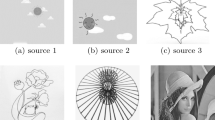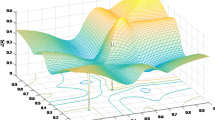Abstract
The Nonnegative Blind Source Separation (NBSS) algorithm based on Minimum Volume Simplex (MVS) has a high dependence on the convex hull of mixed scatterplot, in addition, the shape of convex hull is variable, which increases the uncertainty of the algorithm, therefore, algorithms based on MVS have some restrictions on the shape of mixed scatterplot. Particularly, in the most extreme case, i.e. when the mixing system is ill conditioned and the scatterplot degenerates from n-dimension to (n−1)-dimension, these algorithms almost lose the ability of unmixing. On the other hand, the shape of the mixed scatterplot of sparse signals such as speech is generally fixed, specifically, it is an inclined cross in the two-dimension case. This paper proposes an algorithm based on the slope distribution of edge feature scatters. After sparsity mixtures by extracting edge features, the edge feature scatterplot with inclined cross shape can be obtained. By statistical the slope distribution of edge feature scatterplot, the optimal estimation of the mixing matrix can be found by finding the interval extremum of the slope distribution. In order to improve the accuracy of the geometric method, this paper proposes a Minimum Jaccard Index (MJI) criterion to judge whether the estimation of the mixed matrix is optimal or not. The proposed method does not need the assumption of source independence, or even the locally dominant assumption or pure pixel assumption often mentioned in algorithms based on MVS, and this method only needs the source boundedness assumption indeed. Our method is robust to ill condition, which enriches the theory and method of bounded component analysis and makes up for the shortcomings of other related algorithms.












Similar content being viewed by others
References
Arora, S., Ge, R., Halpern, Y., Mimno, D., Moitra, A., Sontag, D., Wu, Y., Zhu, M.: A practical algorithm for topic modeling with provable guarantees. In: International Conference on Machine Learning, pp. 280–288. PMLR (2013)
Babaie-Zadeh, M., Mansour, A., Jutten, C., Marvasti, F.: A geometric approach for separating several speech signals. In: International Conference on Independent Component Analysis and Signal Separation, pp. 798–806. Springer (2004)
Boardman, J.W., Kruse, F.A., Green, R.O.: Mapping target signatures via partial unmixing of aviris data (1995)
Chan, T.H., Chi, C.Y., Huang, Y.M., Ma, W.K.: A convex analysis-based minimum-volume enclosing simplex algorithm for hyperspectral unmixing. IEEE Transact. Signal Process. 57(11), 4418–4432 (2009)
Chang, C.I., Wu, C.C., Liu, W., Ouyang, Y.C.: A new growing method for simplex-based endmember extraction algorithm. IEEE Trans. Geosci. Remote Sens. 44(10), 2804–2819 (2006)
Chen, L., Choyke, P.L., Chan, T.H., Chi, C.Y., Wang, G., Wang, Y.: Tissue-specific compartmental analysis for dynamic contrast-enhanced mr imaging of complex tumors. IEEE Trans. Med. Imaging 30(12), 2044–2058 (2011)
Craig, M.D.: Minimum-volume transforms for remotely sensed data. IEEE Trans. Geosci. Remote Sens. 32(3), 542–552 (1994)
Ester, M., Kriegel, H.P., Sander, J., Xu, X.: A density-based algorithm for discovering clusters in large spatial databases with noise. AAAI Press (1996)
Gobinet, C., Perrin, E., Huez, R.: Application of non-negative matrix factorization to fluorescence spectroscopy. In: 2004 12th European Signal Processing Conference, pp. 1095–1098. IEEE (2004)
Huck, A., Guillaume, M., Blanc-Talon, J.: Minimum dispersion constrained nonnegative matrix factorization to unmix hyperspectral data. IEEE Trans. Geosci. Remote Sens. 48(6), 2590–2602 (2010)
Jia, S., Qian, Y.: Constrained nonnegative matrix factorization for hyperspectral unmixing. IEEE Trans. Geosci. Remote Sens. 47(1), 161–173 (2008)
Jun, X.U., Wang, C.: Spectral unmixing algorithm using nonnegative matrix factorization constrained by maximum distance sums between endmembers. J. Geomat. Sci. Technol. (2019)
Lee, D.D., Seung, H.S.: Learning the parts of objects by non-negative matrix factorization. Nature 401(6755), 788–791 (1999)
Lee, J.S., Lee, D.D., Choi, S., Lee, D.S.: Application of nonnegative matrix factorization to dynamic positron emission tomography. In: 3rd International Conference on Independent Component Analysis and Blind Signal Separation, pp. 556–562 (2001)
Lin, C.H., Bioucas-Dias, J.M.: Nonnegative blind source separation for ill-conditioned mixtures via john ellipsoid. IEEE Transactions on Neural Networks and Learning Systems (2020)
Lin, C.H., Chi, C.Y., Wang, Y.H., Chan, T.H.: A fast hyperplane-based minimum-volume enclosing simplex algorithm for blind hyperspectral unmixing. IEEE Trans. Signal Process. 64(8), 1946–1961 (2015)
Luo, W.F., Zhong, L., Zhang, B., Gao, L.R.: Null space spectral projection algorithm for hyperspectral image endmember extraction. J. Infrared Millim. Waves 4, 69–82 (2010)
Manton, K.G., Lowrimore, G., Yashin, A., Kovtun, M.: Cluster analysis: overview. Statistics Reference Online, Wiley StatsRef (2014)
Miao, L., Qi, H.: Endmember extraction from highly mixed data using minimum volume constrained nonnegative matrix factorization. IEEE Trans. Geosci. Remote Sens. 45(3), 765–777 (2007). https://doi.org/10.1109/TGRS.2006.888466
Miao, L., Qi, H.: Endmember extraction from highly mixed data using minimum volume constrained nonnegative matrix factorization. IEEE Trans. Geosci. Remote Sens. 45(3), 765 (2007)
Nascimento, J., Dias, J.: Vertex component analysis: a fast algorithm to unmix hyperspectral data. IEEE Trans. Geosci. Remote Sens. 43(2), 898–910 (2005)
Ouedraogo, W.S.B., Souloumiac, A., Jaïdane, M., Jutten, C.: Simplicial cone shrinking algorithm for unmixing nonnegative sources. In: 2012 IEEE International Conference on Acoustics, Speech and Signal Processing (ICASSP), pp. 2405–2408. IEEE (2012)
Ouedraogo, W.S.B., Souloumiac, A., Jaidane, M., Jutten, C.: Non-negative blind source separation algorithm based on minimum aperture simplicial cone. IEEE Trans. Signal Process. 62(2), 376–389 (2013)
Pauca, V.P., Piper, J., Plemmons, R.J.: Nonnegative matrix factorization for spectral data analysis. Linear Algebra Appl. 416(1), 29–47 (2006)
Pomerleau, F., Colas, F., Siegwart, R.: A review of point cloud registration algorithms for mobile robotics. Found. Trends Robot. 4(1), 1–104 (2015)
Puntonet, C., Mansour, A., Jutten, C.: A geometrical algorithm for blind separation of sources. In: 15 Colloque sur le traitement du signal et des images, FRA, 1995. GRETSI, Groupe d’Etudes du Traitement du Signal et des Images (1995)
Puntonet, C.G., Prieto, A.: Neural net approach for blind separation of sources based on geometric properties. Neurocomputing 18(1–3), 141–164 (1998)
Rigo, P., Paulus, P., Kaschten, B., Hustinx, R., Bury, T., Jerusalem, G., Benoit, T., Foidart-Willems, J.: Oncological applications of positron emission tomography with fluorine-18 fluorodeoxyglucose. Eur. J. Nucl. Med. 23(12), 1641–1674 (1996)
Silva, M., Martinez, B., Figueiredo, E., Costa, J.C., Yang, Y., Mascareñas, D.: Nonnegative matrix factorization-based blind source separation for full-field and high-resolution modal identification from video. J. Sound Vib. 487, 115586 (2020)
Winter, M.E.: N-findr: An algorithm for fast autonomous spectral end-member determination in hyperspectral data. In: Imaging Spectrometry V, vol. 3753, pp. 266–275. International Society for Optics and Photonics (1999)
Acknowledgements
This work is supported by National Key Research and Development Program(Grant No. 2017YFB1002804): Multimodal Data Interaction Intention Understanding in Cloud Fusion and Major Project of National Social Science Foundation of China (Grant No.17ZDA331): Methodology Research on Thinking of Chinese Medicine (2017-2022).
Author information
Authors and Affiliations
Corresponding author
Additional information
Publisher's Note
Springer Nature remains neutral with regard to jurisdictional claims in published maps and institutional affiliations.
Supplementary Information
Below is the link to the electronic supplementary material.
Rights and permissions
About this article
Cite this article
Zhao, M., Wang, Z., Zhao, Z. et al. The algorithm for nonnegative blind source separation using edge feature. SIViP 16, 897–904 (2022). https://doi.org/10.1007/s11760-021-02032-y
Received:
Revised:
Accepted:
Published:
Issue Date:
DOI: https://doi.org/10.1007/s11760-021-02032-y




